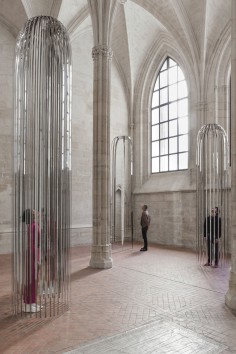TARIK KISWANSON
Vestibule

source:lafayetteanticipationscom
Born in Sweden and of Palestinian descent, Tarik Kiswanson lives and works in Paris. His work, that encompasses sculpture, writing and performance, reflects a commitment to the « poetics of métissage ».
Through different conceptual strategies of interweaving, both in the literal and metaphoric sense, Kiswanson seeks to make visible the need to be « in relation », as articulated by Edouard Glissant. His works are often activated by the presence of the viewer, all the while reflecting in turn his/her own unstable, erased or diffracted image.
The artist graduated from Central Saint-Martins in London and the Beaux-Arts in Paris. His work has recently been exhibited at Fondation d’entreprise Ricard in Paris (2018), MRAC in Sérignan and Mudam in Luxembourg (2017).
.
.
.
.
.
.
.
source:wsimagcom
Through sculpture, performance, and writing, Kiswanson’s practice reclaims and hybridizes personal, cultural and political histories and, in doing so, produces modalities of relation and perception that elicit the contingency of memory, migration, displacement, and interstitiality.
Édouard Glissant’s notion of the “poetics of relation” has greatly influenced the kinetic and responsive qualities of Tarik Kiswanson’s work. As our contemporary moment is one of accelerating multiplicity, thinking relationally can help to actualize a shared world of “infinite difference”. Kiswanson’s practice seeks to translate this idea to the level of perception. A feeling of instability pervades interactions with the artist’s works: highly sensitive to their context, his sculptures respond to their spatial environment by multiplying, refracting, and reflecting their viewers and the surrounding architecture. Whereas Kiswanson’s previous engagements with métissage — which can be understood in his practice as the merging and blurring of origins to uncover unwritten pasts—often had specific material references (amongst other heirlooms, Palestinian embroidery and family silverware), his new works also emerge from a personal space, yet one specifically invested in the elusiveness and variability of memory.
The exhibition takes dreams, visions, and spatial sensations from childhood as its starting point. A series of slender, highly polished steel sculptures will be suspended from the gallery ceiling. Extending nearly to the floor, these hollow cocoon-like structures will appear to levitate. Kiswanson calls his new series of suspended works “Vestibules” — a term that refers both to the structure of the organ in the inner ear that regulates vision and balance as well as to architectural antechambers — quite literally a space between. These organic forms constantly vibrate and rotate. Their shapes are derived from elements of Roman and Islamic architecture, as well as small mechanical pieces used in motor engines. Called Father Forms, these new sculptures obliquely reference the artist’s father, who as a teenager served in the Jordanian Army repairing engines and ventilation systems before exiling to Sweden two decades later where he initially found work in a metal factory and was an avid weekend gardener. The razor thin vertical lines of these suspended forms at times recall sharp, foreboding flower bulbs — evoking the contrast between the heat of mechanical work in the desert and flowers in a cold, Scandinavian landscape.
Unlike previous sculptures, the new metal works beckon you to enter them. Each Father Form becomes a sort of portal, a vessel for a trance-like experience. Upon entering, the spectator will become multiplied, obliterated, and disjointed by the multiple reflections. This sensation is amplified by the profound sonority of the work — it’s an experience that envelops the entire body. Evocative, quasi-hermaphroditic forms, these sculptural vessels blur the boundaries between inside and outside, opening and enclosure, the individual and the collective. The spatial and optical experiences that Kiswanson creates with his Vestibules derive from the highly particular experience and perspective of a first generation migrant. Hybrid, unstable, contingent: always both and neither. He pushes memory and form to the brink of evanescence, rendering them something new — something that fully belongs neither here nor elsewhere.
Tarik Kiswanson (b. 1986) lives and works between Paris and Amman. His solo exhibition All The Things My Eyes Don’t See opens on 18 September at Musée Gallo-romain de Saint-Romain-en-Gal as part of the Biennale de Lyon. Forthcoming solo exhibitions include Fondation Ricard and Fondation Galeries Lafayette (both in Paris). A newly commissioned performance will premiere in November 2017 during the forthcoming edition of the Performa biennale in New York City. Notable previous exhibitions include: MRAC Musée Régional d’Art Contemporain, Collège des Bernardins, Fondation Albert Gleizes, MUDAM Musée d’art modern Luxembourg, IAC Institut d’Art Contemporain Villeurbanne, Centre d’art Pavillon Vendôme, Riga Art Space, Metropolitan Art Society in Beirut, Espace 251 Nord in Liège and Palais des Beaux-Arts in Paris. He has participated in several residencies, most notably: ISCP – International Studio and Curatorial Program in New York and Astérides at La Friche Belle de Mai in Marseille. Kiswanson studied at Central Saint Martins College of Art in London and École nationale supérieure des Beaux-Arts in Paris, where he was respectively awarded first class honors. He was also awarded Prix des Amis de Beaux Arts de Paris in Paris 2014 and has received important grants from Institut Français and the Rothschild foundation (FNAGP) amongst others.
.
.
.
.
.
.
.
source:contemporaneitiescom
Tarik Kiswanson’s artistic practice—which encompasses sculpture, performance, and poetry—evinces an engagement with the poetics of métissage: a means of writing and surviving between multiple conditions and contexts. This crossroad, as cultural studies scholar Paul Gilroy writes, “is a special location where unforeseen, magical things can happen.” The reduction, refraction, multiplication and disintegration of form and language in Kiswanson’s work evoke the contingency of memory and polyphonic hybridity.
The artist’s practice to date has taken up questions of displacement and interstitiality that specifically relate to the context of what is lost, and what is gained, in the first generation of migration. His exhibition at Fondation d’entreprise Ricard expands this inquiry to examine the human condition more broadly, the most fundamental borders—birth and death.

